This morning, the Student Workers of Columbia began a day-long attempt to “shut down campus” as the strike continues, following a message from University administration saying that striking workers may lose their teaching appointments for the Spring 2022 semester.
Entrances to Columbia’s campus are currently being picketed by demonstrators in support of the Student Workers of Columbia as the strike enters its sixth week. Strikers are seen marching around the entrances, occasionally holding hands to form a continuous line while chanting. At the 116 Street and Broadway entrance, a giant inflatable “Corporate Fat Cat,” a cousin of the better known “Scabby the Rat,” can be seen towering over the crowd. The inflatable is a well-known strike symbol.
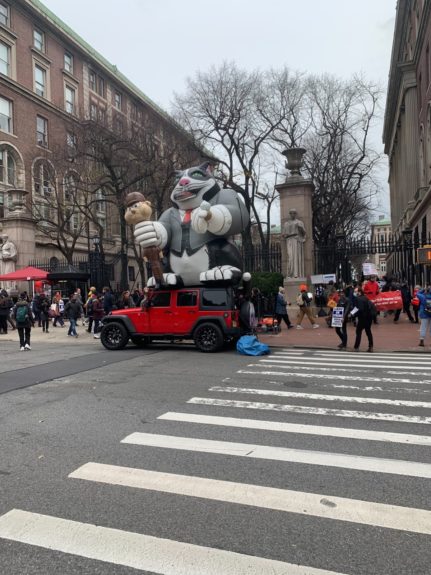
So far, the biggest picketing activity has been seen at the Broadway entrance to campus, though picketers are also at the 116 Street and Amsterdam, Earl Hall, Schapiro, and John Jay entrances.
Bwog was able to confirm the presence of the Professional Staff Congress (PSC) of CUNY and the Association of Legal Aid Attorneys (ALAA). According to a union organizer on the ground, more people from other unions are expected to show up throughout the day, including from NewsGuild, DC 37, Teamsters Local 804, and Health Workers of NY.
“We’ve been fighting for a contract for a long time,” said Daniel, a teaching fellow in the department of Latin American and Iberian cultures. “I’m an international student. All of my income depends on this university. And it would be nice to make a living wage [and] to have real recourse against sexual harassment and discrimination. And to feel safe in the place where we study, where we work.”
As for trying to enter campus, a source trying to get into the John Jay entrance told Bwog that when they tried to enter, they were met by five “friendly” women who said: “We ask that you don’t cross the picket line.”
“I didn’t wanna [sic] cause any trouble,” and they agreed to not enter campus at that point, the source elaborated. “Maybe they would’ve let me in if I said I just wanted food.”
People who do cross the line cannot be physically stopped, according to Jeff, a picket captain. However, he elaborated to Bwog that “we might make them feel a little bad about their decision to pass the picket line verbally… and we try to talk to people before they end up in the middle of a picket line—the physical picket line—and try to explain to them what’s going on and why it’s important.”
According to flyers posted around campus and social media, and organizers on the ground, the demonstrations are expected to last until 6 pm.
On Thursday, December 2, Columbia student workers received an email from the Human Resources Department stating that student workers who continue to strike past December 10 will potentially lose their teaching assignments for the Spring 2022 semester. The SWC is arguing that the lack of protection for their appointments qualifies as a threat to permanently replace striking workers, which is unlawful under the National Labor Relations Board.
The SWC further claims that striking student workers who lose their jobs with the University will be largely unable to continue living in New York City, and many of them may be unable to complete their degree programs. Jackson Miller, a member of the bargaining committee, explained that “there will be a problem to continue living in the city. It’s already hard enough as it is with the poverty wages that Columbia pays us.” He went on to criticize the university’s threat of replacing workers, stating “it’s really just despicable how low they will sink to try to scare us off striking.”
The announcement from Human Resources came just ahead of finals week at Columbia and has stirred up a new wave of support for the SWC from students and professors, including the December 6 walkout, which focused on faculty-led support.
According to sociology PhD candidate and union member Dominic Walker, the organization of the campus shutdown “was in response to that email [about teaching appointments].” Walker also told Bwog that himself and other members of the union “planned [the shutdown] probably as much as we’ve planned any of the other actions that we’ve done during the strike,” in contrast to perceptions that the shutdown was organized last-minute.
As of the writing of this article, union members are optimistic about the results of the shutdown. Gesturing to a mostly empty campus, SWC member and PhD student Tamara Hache told Bwog: “The show of solidarity from all around the city has been really inspiring. And I think that really pushed forward this action, and that’s why it’s so successful already, only a couple hours in.”
Union member Daniel told Bwog that there are no plans to stop picketing “in hopes that the University will wake up, smell the cappuccino, [and] sign a fair contract, so we can get back to doing what we love, which is teaching, which is being with our students, and being with our research.”
Update on December 8 at 3:55 pm:
As of the writing of this article, union members are optimistic about the results of the shutdown. Gesturing to a mostly empty campus, SWC member and PhD student Tamara Hache told Bwog, “The show of solidarity from all around the city has been really inspiring. And I think that really pushed forward this action, and that’s why it’s so successful already, only a couple hours in.” Other shows of solidarity for the SWC’s picketing have included faculty support, support from prominent figures, and honking from vehicles passing by; one staff writer witnessed an MTA bus honking in support for the strikers at the 116 Street and Broadway entrance, an event that was also posted on the SWC’s Twitter. In contrast, those who were seen crossing the picket line were booed by the picketers, according to Bwog eyewitness accounts.
In Columbia’s second communication to students about the shutdown, Executive Vice President for University Life Dennis A. Mitchell and Executive Vice President of University Facilities and Operations David M. Greenberg offered guidance to students on how to enter campus during the period of picketing. The email, which can be found in full below, stated that students should look for a public safety representative if they feel they need assistance entering or exiting campus through the picket line. The email suggests alternative entrance and exit points for students, mostly through campus buildings that have both campus and street entrances.
Update on December 8 at 6:07 pm:
The picket concluded outside Schermerhorn Hall at around 5:30 pm. President Lee Bollinger had his “Freedom of Speech and Press” class in the building around then (from 4:10 to 5:25 pm), but he concluded his class early. Bollinger was escorted out of the building while students were left to exit on their own. Picketers did not attempt to enter the building, around and in which Public Safety officers could be seen.
Picketing will continue around the 117/118 and Broadway service entrance to prevent an oil delivery, which should happen at around 8 pm.
According to an announcement made as the picket wrapped up, the strike will continue: 87.3% of people currently striking want to continue the strike, and 77% of those not currently striking but who support the strike want it to continue.
Email from Executive Vice President for University Life Dennis A. Mitchell and Executive Vice President of University Facilities and Operations David M. Greenberg sent to students on Wednesday, December 8 at 2:48 pm:
Dear Columbia Community:
During today’s Student Workers of Columbia – United Auto Workers Local 2110 picketing at entrances to the Morningside campus, there have been isolated reports of difficulty accessing and exiting campus. In an effort to maintain everyone’s safety on campus today, if you feel you need assistance entering or exiting campus through the picket line, please look for a public safety representative.
Please also consider using alternate exits to the street available through Lerner Hall (115th Street and Broadway), the Northwest Corner building (120th Street and Broadway), the Mudd Building (120th Street and Amsterdam), among others.
Thank you for your consideration and cooperation in maintaining the safety of our shared community.
Respectfully yours,
Dennis A. Mitchell (he/him/his)
Executive Vice President for University Life
Senior Vice Provost for Faculty Advancement
Professor of Dental Medicine at CUMC
David M. Greenberg
Executive Vice President
University Facilities and Operations
Reporting contributed by Rania Borgani, Sarah Braner, Victoria Melkonyan, Anya Kopyra, Paulina Rodriguez, Elizabeth Walker, Kyle Murray, Henry Astor, and Charlie Bonkowsky.
This is a developing story. Check back for updates.
Images via Bwog Staff


 36 Comments
36 Comments

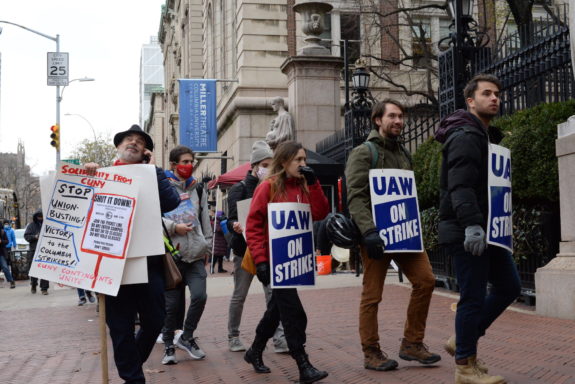

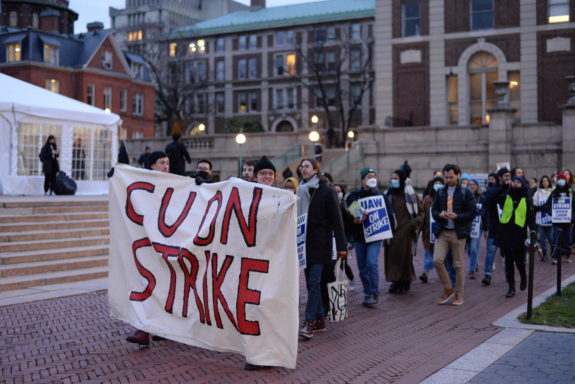
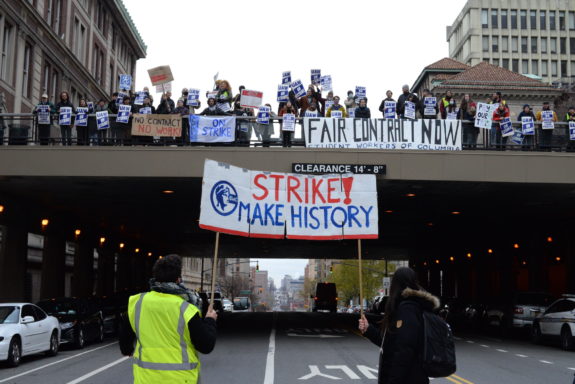
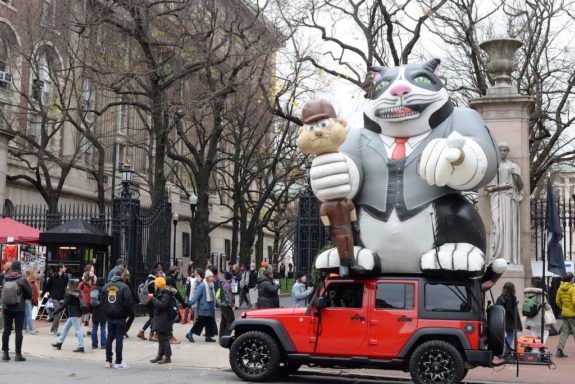
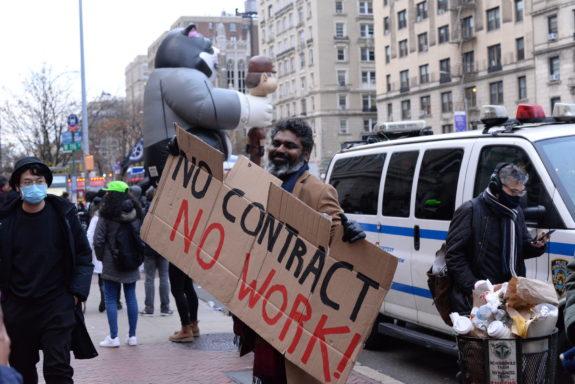
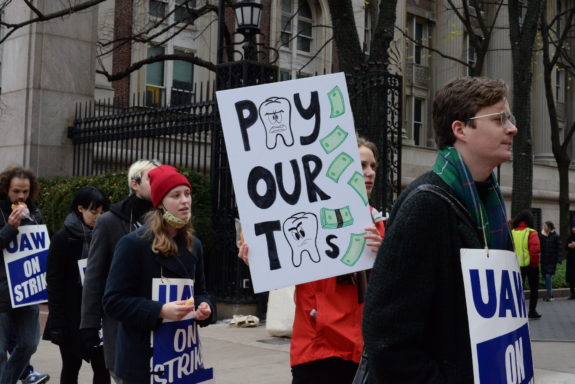
36 Comments
@Anonymous Bwog, this has been your lead article for like ten days now. Shows what side your on, we get it. But time to remove and replace with more current news.
@Anonymous I read on Instagram that some grad student was complaining about the cost of in vitro fertilization and that her health insurance doesn’t cover all of the costs. Seriously? That’s what you’re striking for? We are not responsible for subsidizing your reproductive inclinations. If you’re so interested in the plight of the poor, as you claim by saying Columbia steals property in Harlem, then why don’t you adopt a kid in foster care? Better than bringing another resource-hogging American into the population. Next she’ll be complaining that the child care subsidy she is offered doesn’t cover the cost of one the elitist preschool she wants to send her kid to. You all complain that your elitist, Ivy League School subjects you to “inhumane working conditions.” Try picking product or working in a chicken parts factory. No wonder the general population thinks academia is a joke.
@Anonymous They also want free eye and dental care and free childcare and schooling for their kids. Not even CEOs on Wall Street get that. Don’t they realize they are students without degrees or credentials.
@tits on a boar University should give them this. Most will end up alone, unhappy, and childless. Take a look at them — not exactly on top of the reproductive hierarchy!
@Anonymous Why do these grad students think they should be earning a living New York City wage while getting a free education? Education is a luxury that not everyone can afford. You either work and make a living, or go back and get a degree and live frugally. You don’t get to do both.
@Anonymous Not sure where the very biased bwog and spec get the notion that the undergrads support this strike. The overwhelming majority of students and parents do not support this at all.
@Bill Great. Now the protestors are harassing and accosting students, destroying property, and writing graffiti on historic buildings. Enough is enough. They are not winning over any students with their terroristic tactics.
@Anonymous Today, I tried to get into campus and was blocked off at every entrance. I went from 114th – 120th, I tried both main entrances, the Earl Hall entrance, the John Jay entrance, even the revolving door at Ferris to get into campus through the bookstore, but protestors stopped me at every turn. The Mudd hall entrance, which was supposed to be open, was blocked off by the protestors who screamed obscenities and booed people who tried to cross the picket line, physically blocking them and physically intimidating them. I wasn’t even trying to go to a class, I wanted to go to my room and then get some dinner. I told them this and they told me, “Too bad.” The official union instagram said, I believe, that students who wanted access to their dorms and dining halls could pass and were not considered to cross the picket line, but that is obviously not true. I had to stay off campus for hours in the cold, wandering around until 5:40 PM when the strike died down. I didn’t know I’d be off campus for so long, so I was freezing and didn’t even have my wallet, so I couldn’t go anywhere to sit down and wait it out. The protestors said, “Thank you for supporting the strike!” when I finally gave up at 120th and left. I don’t support the strike, I was afraid of physical retribution for crossing the line! Not all of the undergrads support the strike, not even close.
@Anonymous I was helping to clear out the office of my recently deceased friend. Accompanying her bereaved spouse, carrying her things, I was screamed at by a striker blocking our way as we tried to get OFF campus. What purpose was served by that?
@Anonymous I’ll take things that never happened for 1000, Alex
@Anonymous Sadly, it actually did happen.
@Anonymous >and then everyone clapped
@Anonymous I and many of my friends were physically pushed when attempting to go around picketers to access campus. Demonstrating is one thing, but using force against students not involved is something else.
@Anonymous Honestly, crossed the picket line eight or more times. You just keep walking and ignore the crazy people just like any other sidewalk in NYC. Both times that I got food at John Jay and Ferris they were at least 2/3 full at off-peak times. I went to Avery and, while there were free seats, it was by no means empty. And yes, the East Asian library was mostly empty, as was College Walk (as pictured). But, there were plenty of people on campus in places that were not within earshot of the incessant screeching. Also, if you take a picture in between classes during the winter, it’s not like college walk is typically packed either. I went to classes that were all at least 1/2 full and one of them was literally taught by a graduate student in the bargaining unit. In another class, we took our last test prior to the finals and, magically, the entire class managed to be there. So, no, the university was not shut down to the extent that the union is claiming, and, no, there is not universal consensus in favor of the strike among students.
@Anonymous Correct. Most students are angry at the grad students striking and disrupting academic life. And for the record everything was open and 99% of classes went on.
@Anonymous I’m an adjunct. I make $16,000 for teaching a two-semester Core course. If graduate students are to be understood purely as workers, I don’t understand why they should be paid roughly 3x what I am paid, plus health insurance, free tuition, and access to subsidized housing, for doing the same work, with less experience. I get that the University could afford to pay it–but does that mean they have to?
@Anonymous Sounds like you should start a union.
@Anonymous Sounds like you should join a union.
@Anonymous Perhaps adjuncts at Columbia should organize.
@Frank Abagnale, Jr. No, they don’t have to, that’s why student workers are on strike. The state of and reliance on adjunct labor in academia is another travesty attributable to the same fundamental corporatization of the university that underlies Columbia’s resistance to granting workers from both of these labor pools a living wage. We’re all in this together! Student workers at Columbia absolutely support the plight of adjuncts.
@Anonymous poor guy alert! Hey Frank, how’s the Ramen you pleb!
@Anonymous My point was not that I am underpaid (I don’t think I am) but that the graduate student strike is not about “wages.” With regard to preceptors who teach one class–I know that doesn’t describe everyone’s situation–no university would ever pay anyone $45,000 to do a part-time job, nor would it be reasonable for them to do so. What the union want is more support. And maybe they should get it, but to claim they are “underpaid” is very hard for me to swallow.
@Anonymous Not that you actually cared to get your facts straight before spitting on your junior colleagues, but:
a) when you adjust for cost of living, Columbia pays its student workers far less than peer institutions, despite being located in one of the most expensive cities in the US
b) in New York, NYU already pays its student workers MORE than what SWC is demanding, despite having a smaller endowment
c) “subsidized housing” is a joke, rent in CU housing is often equivalent or higher than in neighboring areas
d) health insurance for student workers currently provides very poor coverage for student workers, no dental, no vision, insufficient childcare. Parents and people with health conditions or medical emergencies go into debt or drop out of their program
e) If 16k is the total you make in a year, then I’m sorry but you’re absolutely underpaid by Columbia own standards. Ask around what core lecturers get to do the exact same job as you.
f) If teaching in the core is a “part-time job” or a side-gig for you, great! For many student workers, particularly for international students (more than 50% of GSAS) who CANNOT legally work outside campus, this is the only possible source of income. If they don’t come from an affluent family they often end up in debt.
Having said this, adjuncts deserve absolutely to be paid more, to have adequate healthcare and protections, and to be able to make a living in the city. And so do student workers.
@Anonymous Econ 101. Supply and Demand. University gives grad students what the market will bear. If Supply of qualified grad students is higher than Demand for grad students, price falls. If Supply is lower, price rises. Sinple really!
@Anonymous No job gives dental, vision, or childcare. That comes out of everyone’s pockets in every job. It is not Columbia’s responsibility you have two kids. It is ridiculous what they are demanding. There are grad students dying to go to Columbia for anything. You can easily be replaced.
@Frank Abagnale, Jr. So essentially your argument boils down to the claim that graduate students across the board in PhD programs should be expected to take on loans to fund their degrees in much the same way that undergraduates do? I agree that this is the way that academia had been heading for the past 40 years, but I don’t think it’s a future we want to be cheering on, and that’s why so many of us are taking risks to fight against this trend.
@Anonymous >students across the board in PhD programs should be expected to take on loans to fund their degrees in much the same way that undergraduates do
YES. Then pay back the loan.
@Anonymous Sounds like you should join a union!
@Anonymous Have you thought about joining a union?
@Columbia alumni parent Not a big donor but a regular donor and all of my donations are going to the Columbia Student worker strike fund until this is resolved.
@Parent Good luck. Tuition will go through the roof with their demands.
@Anonymous This is an INSURRECTION! I’m LITERALLY SHAKING! Someone call the FBI
@Anonymous I swear y’all have never heard of a picket before or choose not to care and would rather make light of it. If you were a grad student who was being sexually harassed by faculty you’d care damn well that your contract included 3rd party arbitration.
@Anonymous Why do you say y’all? Are you from the South? Why are you even here?
@Anonymous Is THAT what all those ugly people were doing?
@Anonymous These students are really damaging student life and academics. Columbia really needs to get rid of them. Harvard didn’t rehire many of its students.